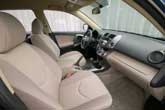Recent Articles
Popular Makes
Body Types
2006 Toyota RAV4 First Drive
Little ‘bro just got really big, bad and best of class
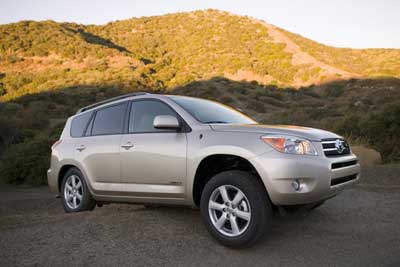
Welcome to the age of Toyota. Hyperbole, perhaps. Or maybe a salutation that’s a bit late, depending on your perspective. The reality, however, is that the gulf between the largest automaker in the world, General Motors, and the real number one automaker in the United States, Toyota, has never been greater and is brutally symbolized by the 2006 Toyota RAV4. While GM cuts jobs and closes plants, while GM frets over the bankruptcy of its main supplier, Delphi, Toyota unveils a compact SUV that is anything but small, a vehicle that effectively straddles two classes of SUVs, simultaneously hitting the sweet spot of a market that demands the comfort of a car, the utility of a truck, and the performance of each. Most of the time, an automaker spends millions – maybe billions – to develop a vehicle that gently nudges ahead of the competition. This is the automotive circle of life, and it dictates that car makers play an endless game of “can you top this?” giving buyers a wide array of choices, depending on their tastes, and spurring competition. The 2006 Toyota RAV4 blows that circle to smithereens. It effectively becomes the nicest riding, most powerful and technologically advanced compact SUV on the market. It also becomes a serious consideration for those looking for a vehicle that’s bigger, coming close to matching large SUVs such as the Nissan Pathfinder and even Toyota’s own Highlander for size (V6 engine) and power – and doing so for thousands of dollars less. Add to that the impact of rising fuel prices on SUV sales, evidenced by row after row of large vehicles gathering dust on dealer lots, and the RAV4 becomes a cornerstone of Toyota’s future success – and serious bad news for the competition. It wasn’t always that way. Originally brought to North America in 1996, the RAV4 was one of the first car-based SUVs, the kind of car that combines the ride of a sedan with the usefulness of a utility vehicle, namely an up-high seating position and plenty of cargo space. It sold very well, but was hampered by exterior styling some viewed as cartoonish and effeminate. Toyota went about changing that with this new version, moving the 2006 RAV4 to a new, larger platform and giving it a class-leading 269-horsepower V6 engine. The result is an SUV that may be considered a little bland to some, but iss wider and longer, looks tougher, offers streams of power, and gives a resounding advantage to Toyota in one of the most profitable car markets in the world. Welcome to the age of Toyota, indeed.
Model Mix
Model Mix The top trim of the 2006 Toyota RAV4, the Limited V6 with 4WD, sells for $25,870, including destination – around $2,000 more than the 2006 Hyundai Tucson LX 4WD, but with almost 100 more horsepower. Imagine the audacity of Toyota. With “domestic” auto plants closing left and right, with the competition struggling to equal the design and quality of Toyota’s previous model year vehicles, it comes out with a small SUV that almost offers the power and room of a mid-size SUV but at a price that would make an accountant choke. Try this on for size: an MSRP of $20,300 for the four-cylinder base model with front-wheel drive. That’ll get you an engine that makes 165 horsepower, ten more than the Honda CR-V equivalent, for about the same amount of money. For just a touch more than two grand, or $22,335, you can purchase a base version of the new V6 variant. This will give you 269 horsepower, around 100 more ponies than the CR-V – which comes only with a four-cylinder engine. All Toyota SUVs get the Star safety system, which includes Vehicle Stability Control (VSC), Traction Control (TRAC), and an Antilock Braking System (ABS) with Electronic Brake-force Distribution (EBD) and Brake Assist (BA). The 2006 Toyota RAV4 base model comes with P215/70 tires mounted on 16-inch steel wheels and a full-size spare tire, while the V6 variant adds an inch to the wheel and tire size. Also standard is a six-speaker stereo with a CD player, an auxiliary jack and MP3/WMA playback capability. The base RAV4 includes black-painted door handles and grille, power folding outside mirrors, cruise control with a brake deceleration feature, and fabric seats with six-way manual adjustment for the driver and four for the front passenger. Even the second-row seats get fore-aft and recline features, and they fold flat in a 60/40 split. All 2006 Toyota RAV4s get remote keyless entry, ten cupholders, power windows with one-touch auto down, three auxiliary power outlets, an outside temperature gauge, a tilt and telescoping steering wheel, and a tire pressure monitor. Other nifty standard features include illuminated front cupholders, auto-off headlamps, a dual glove box, and rear deck storage including a water-repellent and folding deck board. Available options on the base RAV4 include a six-disc in-dash CD changer, daytime running lights, black painted roof rails and cross bars, P225/65 R17 tires with either 17-inch five-spoke aluminum alloy wheels or 17-inch five-spoke steel wheels, a fabric-trimmed 50/50 split third-row seat, a cargo area tonneau cover with a multi-purpose cargo net and support poles, and a tow package for V6 models that increases towing capacity to 3,500 pounds. There’s a limited slip differential on the off-road models, and all RAV4s get Toyota’s 36-month/36,000-mile limited warranty. An additional 60-month/60,000 mile warranty covers the powertrain. Moving up to the Sport model adds P235/55R18 tires with alloy wheels and a full-size spare tire, color-keyed door handles, fender flares, heated outside mirrors, black painted roof rails, fog lights, smoked headlamps, a sport-tuned suspension, dark charcoal fabric seats. and a partial hard spare tire cover. Prices for the RAV4 Sport range from $21,875 for the 2WD trim with a four-cylinder engine to $25,190 for the V6 with 4WD. Available features on the new Sport grade include a power tilt/slide moonroof, a six-disc CD changer with nine JBL speakers and a subwoofer, and steering wheel audio controls. Sport models cannot be equipped with the optional third-row seat. The top trim, the RAV4 Limited, gets P225/65R17 tires with 17-inch six-spoke alloy wheels and a full-size steel-wheel spare, dual-zone air conditioning with air filtration and pollen removal, an in-dash six-disc CD changer, an engine immobilizer, interior footwell lighting, a leather-wrapped steering wheel with audio controls, a leather-wrapped shift knob, an eight-way power driver’s seat with lumbar, a tonneau cover with cargo net and support poles (except for third-row versions), a full hard-shell spare tire cover, and a chrome grille. Options for the Limited include leather-trimmed seats, heated front seats, a rear seat DVD entertainment system with rear seat audio, and an exclusive Blizzard White Pearl exterior paint. The 2006 Toyota RAV4 Limited starts at $22,555 with a four-cylinder engine and 2WD. The 4WD Limited sells for $23,955, while the 2006 Toyota RAV4 Limited V6 with 4WD sells for $25,870 – around $2,000 more than a 2006 Hyundai Tucson LX 4WD, but with almost 100 more horsepower. More comparable in price, but very different in mission, would be the 2006 Nissan Xterra Off-Road with a 265-horsepower engine. The Xterra is priced slightly higher, at $26,050, and offers a rougher, trucky ride, but provides off-road capability that is worlds better than what’s offered in the RAV4. For shoppers who don’t need robust off-road capability, however, either the Base or Limited variant of the RAV4 should do the trick. And while the four-cylinder is a fine motor should you be in that market, it’s hard to argue against a V6 putting out that type of power.
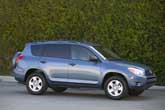
Nuts and Bolts
Nuts and Bolts New for the 2006 Toyota RAV4 is an Electronic Power Steering (EPS) system that’s designed to provide better, more precise control than a standard hydraulic system. You could say that when it comes to small SUVs and power, change is in the air like smog is in the L.A. basin. And it starts with the RAV4. Though other automakers have recently amped up the power of their small utility vehicles, the RAV4 is one of the first car-based SUVs with a significant, class-leading amount of power. So if you think the 2006 Toyota RAV4 is a wind-up car with room for groceries, it’s time to change your thinking. The new RAV4, especially with its optional V6 engine, is a powerful SUV poised to change the rules by which small SUVs are judged. Consider that the RAV4’s 3.5-liter V6 engine generates 269 horsepower at 6,200 rpm and delivers 246 lb.-ft. of torque at 4,700 rpm, inside a vehicle penciled in as a competitor for the Honda CR-V and Hyundai Tucson. Realistically, the only vehicles even close in terms of power and price would be the Ford Escape and Nissan Xterra, which offer 200 and 265 horsepower, respectively, at comparable prices. The V6 is new and a jewel of Toyota’s engine lineup, and it should be. Mated to a five-speed automatic transmission, Toyota says the V6 will power the 2006 RAV4 from 0-60 in under seven seconds, while delivering EPA fuel economy ratings of 22 city/29 highway for 2WD model and 21 city/28 highway for 4WD versionss. The Toyota RAV4’s automatic transmissions also feature uphill and downhill shift logic, which reduces the amount of shifting while either driving up or down a steep incline. For those shopping puny little powertrains, the 2006 Toyota RAV4’s four-cylinder gets five more horsepower this year, up to 166 at 6,000 rpm, and 165 lb.-ft. of torque at 4,000 rpm. The 2.5-liter engine is mated to a four-speed automatic transmission, and Toyota claims that it is one of the most powerful four-cylinder engines in the small SUV segment. A quick glance at the competition shows that it has a little more grunt than most, including competitors such as the Honda CR-V and Ford Escape. Fuel economy for the four-cylinder engine is rated at 24 city/30 highway on 2WD configurations and 23 city/28 highway on 4WD models. Both are expected to be certified as Ultra Low Emission Vehicle II (ULEV2) vehicles. What’s more, Toyota has added space to enhance the engine lineup, and the result is an SUV that will likely give its competition fits, not just in terms of power but in areas of handling and interior room as well. That’s evident by its underpinnings, a four-wheel independent suspension with redesigned MacPherson struts up front and trailing double wishbone suspension in back that’s designed to maximize space in the cargo hold. Also new for 2006 is Toyota’s pseudo full-time four-wheel-drive, an electronically controlled system that automatically distributes torque between the front and rear wheels, allowing the RAV4 to switch from front-wheel-drive to four-wheel-drive mode as conditions warrant. There’s also a 4WD manual locking switch that shuts down the auto mode and sends power to all four wheels, until the SUV reaches 25 mph – at which point the RAV4 goes back to a front-wheel-drive setup. Toyota has also included standard Hill-start Assist Control (HAC) and Downhill Assist Control (DAC) on all RAV4s equipped with a V6 engine as well as four-cylinder models with the optional third-row seat. HAC keeps the vehicle still while starting off on an incline or slippery surface, and DAC helps control downhill speeds when traveling in low gear. The technology treats continue with the RAV4’s steering components. New for this year is an Electronic Power Steering (EPS) system that’s designed to provide better, more precise control than the standard hydraulic system in the previous RAV4. It works by providing computer-controlled assistance to the driver when needed, thus eliminating the need for a power steering pump. A benefit to the electronic steering is that steering control is now connected to the RAV4’s myriad electronic safety systems – VSC, TRAC, ABS with EBD and BA, providing input regarding lack of control from the steering wheel, and applying power – or taking away – where needed.. All of this hardware is connected to 16-, 17- or 18-inch tires and wheels, depending on the trim you choose. These wheel sets are stopped by either 15-or 16-inch ventilated disc brakes up front (16-inch for V6 models and those with a third row) and 11.1-inch disc brakes in back.
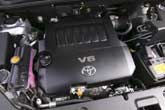
Exterior Design
Exterior Design While it’s nice to have a full-size spare tire on a new car, and while dropping a tire from under a wounded car is a dirty, damnable experience, for the sake of vanity, we’d go ahead and put the thing down there and let the 2006 Toyota RAV4 grab a new identity. The good news: The 2006 Toyota RAV4 is no longer a “chick” car, apologies all around. And it no longer looks like a tennis shoe, thank heavens. Yup, most of the reasons people wouldn’t buy the RAV4 are gone: It no longer looks like a Special Agent Kim Possible Shoe Car. But we still don’t love it. Ahh, okay, we like it quite a bit. It looks good, but is still a bit bland, and no matter how many practical arguments there may be, the tire on the back gate is out of place. First, it ruins what would be a nicely designed rear, destroying the overall look of the vehicle and putting a hard-shell case around the thing just makes it worse. Second, putting the spare up there should be reserved for Jeeps and such; hardy roughneck vehicles that sing songs of dirty utility. It may be iconic for the RAV4, but it’s an ugly icon. And while it’s nice to have a full-siz spare on a new car, and while dropping a tire from under a wounded car on the side for the road is a dirty, damnable experience, for the sake of vanity we’d go ahead and put the thing down there and let the RAV4 grab a new identity. As of now, that identity is one of practicality, as much of the RAV4’s redesign intends to make things quieter and more comfortable inside the cabin. Thanks to its new and larger platform, the RAV4 has a wider, meaner look. By larger, we mean 14 inches longer – enough to make the claim that this RAV4 really is nothing like the outgoing model, except for that crazy spare tire in the back. Its new look is certainly more masculine, if not downright aggressive, even though its subtle sheetmetal angles infuse the RAV4 with a more serious and upscale appearance where previously it had the character of a cartoon.

Interior Design
Interior Design It’s in the first two rows, and available cargo space, where the 2006 Toyota RAV4 makes its name. Sit in the back and enjoy headroom and foot room that borders on mid-sized SUV territory. Of all the things that matter when it comes to buying a vehicle, of all the talk of power, handling, price, and fuel economy, perhaps the most important area when it comes to SUVs is space – usable, friendly and smart interior space that helps make day-to-day tasks easier to manage. Up to now, the knock on small SUVs has largely been that these vehicles don’t accommodate growing families. You can buy a Honda CR-V, but once little Charlie and Charleena come along, all that convenient elbow room suddenly gets pretty darn cramped, and the next thing you know – poof – you’re off to minivan-land. The 2006 Toyota RAV4 changes that. And in a big way, with big room inside for drivers and passengers. There’s even an available third-row seat, though it’s little more than a jump seat. Smart buyers will purchase a RAV4 that offers underfloor storage instead of the optional, teeny-tiny third row. No matter. It’s the first two rows, and available cargo space, where the RAV4 makes its name. Sit in the back and enjoy headroom and foot room that borders on mid-sized SUV territory. Back here, you’ve got cupholders where they ought to be (there’s ten in all), and reclining seats that are among the best offered in the second row of a small SUV. Okay, so maybe it’s not fair to even call the RAV4 a small SUV. After all, it’s 14 inches longer than its predecessor. So to compare it in size to its traditional competitors, well, that’s a bit like stacking the deck. Like a lightweight fighter who moves up a class, the 2006 RAV4 suddenly looks smaller – but not by much. How’s this for irony: Toyota’s own Highlander, which costs a little more than $4,000 over the RAV4, is only four inches longer and is virtually the same width-wise. Headroom and legroom up front is actually more expansive in the RAV4 than it is in the Highlander. Look for Highlander rebates coming soon, at a Toyota dealer near you. It’s as if the RAV4 was everybody’s little brother, grew up, spent some time at the gym, and started taking names. The fact that all this interior space is well used should come as no surprise, for it’s safe to say that Toyota has pretty much nailed down the making of practical, convenient cars. Shoot – the thing has a dual glove box and illuminated cupholders. And though the models under evaluation were pre-production, you can assume that the 2006 Toyota RAV4 will get as much attention to detail regarding component quality and gap tolerance. As for interior layout, there are some interior changes from the Toyotas we’re all used to, such as the center console and larger door grips. All are easy to use, and attractive in appearance, though those big and beefy door grips look faintly like the ones in the Honda Ridgeline. With chrome-brushed inserts throughout the cabin and quality materials on the seats, living in the RAV4 is pleasant. The seats are well-bolstered and comfortable, and the material is pleasant to touch. Headrests in the second row are set into the seatback, which improves visibility and convenience when lowering them for cargo. When you need to drop the second row for a home improvement errand, the RAV4 provides a nice, large area that has smooth walls with few intrusions.
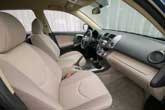
Driving Impressions
Driving Impressions With two powertrains remarkably well-mated to either a four- or five-speed automatic transmission, to the new size and weight of the vehicle, someone who purchases the 2006 Toyota RAV4 will not go wishing for fishes. Warning: If you’re looking for 0-60 times and skidpad read outs, you’ve come to the wrong place, my friend. The 2006 Toyota RAV4 is about performance in the classic sense just as much as George Steinbrenner is about losing with class. What it is about, however, is that transparent kind of performance Performance that is powerful and smooth, the kind that makes you scarcely notice what you’re driving. Sorry about that, Toyota engineers. But no one really hangs out in the garage and talks about their RAV4 with buddies over a beer. And while that seems a shame, it’s not, for the fact is that the RAV4’s kind of performance is harder to achieve than it seems. The auto market is chock-a-block with vehicles – especially SUVs – that lack power or feel of the road, so much so that a driver is likely to look down and curse, or wish that he had enough cash to buy the upgraded package. Accelerating from traffic lights, changing lanes, driving up hills, turning into parking spots, these are the tests a vehicle such as the RAV4 must pass, and it must do so in such a way as to provide an effortless experience. No one wants to own a car that makes you feel like you’re walking up a mountain, and if you step on the accelerator of your car and count to three before anything happens, well, welcome to the dirty struggle. On that score, the 2006 Toyota RAV4 is champ. Period. With two powertrains remarkably well-mated to either a four- or five-speed automatic transmission, to the new size and weight of the vehicle, someone who purchases the new RAV4 will not go wishing for fishes. As for the test: Standing on the RAV4’s accelerator elicts a hearty response, especially from the 269-horsepower V6 engine. Even the four-cylinder, though whiny, provides good power. But forget the four-cylinder. If you’re thinking of buying the new RAV4 version with the four-cylinder engine, but wonder whether it delivers enough power, go ahead and buy one now. It’s an adept engine that pulls the larger RAV4 without much trouble, even getting up to speed in a decent amount of time. As noted, however, expect a whiny note and a less-refined manner than the new V6. Even with a transmission that controls hunt up and down hills, you can feel the RAV4 four-banger shifting through the gears, and can catch it by surprise with a sudden tweak of the accelerator. That, of course is to be expected, and if you’re shopping for a four, you should already have accepted it. Ah, but that V6 is a nice engine, perhaps the best thing about the RAV4. The 269-horsepower V6 engine is among the most responsive in its class. Under hard acceleration, the transmission shifts smoothly, with little lurch or hesitation, launching the RAV4 smoothly up the powerband and delivering torque where it’s needed, from a standing start and at cruising speed. Handling, while suffering from the typical SUV boat blues, is capable enough to keep the RAV4 on the road and even though it’s much longer than before, the RAV4 hass a tight turning radius that will make a mockery of No U-Turn signs everywhere. The brakes are receptive and suffer little extra play, though the feeling is muted – as is the steering. With all the electro-gadgetry, the feel of driving has been compromised. True, the benefits of moving parts into the electric world are numerous and significant; but sadly, for enthusiasts, this technology consistently provides a numb, plastic driving experience. Give me some good old hydraulics any day. As for the in-cabin driving experience, the 2006 Toyota RAV4 is sublime. Controls are placed nicely, gauges are clear and easy to read, and the tilt/telescoping steering wheel is especially nice, as it helps people of all statures find a more comfortable driving position. The cabin is quiet in most normal driving situations, such as smooth pavement, rough pavement and freeway tarmac, and climbing into the RAV4 is as easy as most SUV of its ilk, thanks to a 7.5 inch clearance.
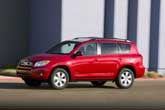
Specifications
Specifications The 2006 Toyota RAV4’s main competitors include the Chevrolet Equinox, Ford Escape, Ford Freestyle, Honda CR-V, Honda Element, Hyundai Santa Fe, Hyundai Tucson, Kia Sportage, Mazda Tribute, Mercury Mariner, Mitsubishi Endeavor, Nissan Murano, Pontiac Torrent, Saturn VUE, Subaru Outback, and Toyota Highlander. Test Vehicles: 2006 Toyota RAV4 Base 2WD with four-cylinder engine/2006 Toyota RAV4 Limited 2WD with V6 engine Price Range: $20,300 - $25,870 Engine Size and Type: 2.5-liter four-cylinder/3.5-liter V6 Engine Horsepower: 166 hp at 6,000 rpm/269 hp at 6,200 rpm Engine Torque: 165 lb.-ft. at 4,000 rpm/246 lb.-ft. at 4,700 rpm Transmission: Four-speed automatic/five-speed automatic Curb Weight, lbs.: 3,527 Base 2WD; 3,547 Limited 2WD; 3,549 Sport 2WD; 3,655 Base 4WD; 3,675 Limited 4WD; 3,677 Sport 4WD EPA Fuel Economy (city/highway): 24/30 (2WD 4-cyl.); 22/29 (4WD 4-cyl.); 23/28 (2WD V6); 21/28 (4WD V6) Length: 181.1 inches (with spare tire cover) Width: 71.5 inches Wheelbase: 104.7 inches Height: 66.3 inches Legroom (first/second/third rows): 41.8/38.3/30.0 inches Headroom (first/second/third rows): 40.8/39.8/37.2 inches Max. Seating Capacity: 7 (with third row) Max. Cargo Volume: Behind front row 73.0 cubic ft./Behind second row 37.2 cubic ft. max. Payload: 2WD: 1,051 (Sport) – 1,348 (Limited) 4WD: 1,065/1,360 Base;1,045/1,340 Limited; 1,043 Sport Max. Towing Capacity: 3,500 lbs. Ground Clearance: 7.5 inches Competitors: Chevrolet Equinox, Ford Escape, Ford Freestyle, Honda CR-V, Honda Element, Hyundai Santa Fe, Hyundai Tucson, Kia Sportage, Mazda Tribute, Mercury Mariner, Mitsubishi Endeavor, Nissan Murano, Pontiac Torrent, Saturn Vue, Subaru Outback, and Toyota Highlander.
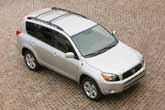
FAQs
FAQs How does the 2006 Toyota RAV4 stack up power-wise? It’s among the most powerful offering in its class. The 269-horsepower V6 engine is class-leading, while the four-cylinder engine competes well with competitors such as the Honda CR-V. What kind of “real” fuel economy does the 2006 Toyota RAV4 get, and is it competitive with other small SUVs? You’re likely to get around 18-20 miles per gallon from the RAV4, depending on the engine you choose, how you drive and whether or not you keep your vehicle maintained. We’ll report on actual fuel economy once we thoroughly test this vehicle. According to preliminary EPA estimates, however, the RAV4 looks to be competitive with most SUVs of its ilk. How does the 2006 Toyota RAV4 stack up power-wise? It’s among the most powerful offering in its class. The 269-horsepower V6 engine is class-leading, while the four-cylinder engine competes well with competitors such as the Honda CR-V. How much more expensive is the 2006 Toyota RAV4 compared to the 2005 model? Toyota claims to have bumped up the prices around 1 or 2 percent, keeping the RAV4 competitive based on price, trim and features. There are less expensive SUVs, but you’d be hard pressed to find one that offers a lower price and as many features.
Photos courtesy of Toyota
